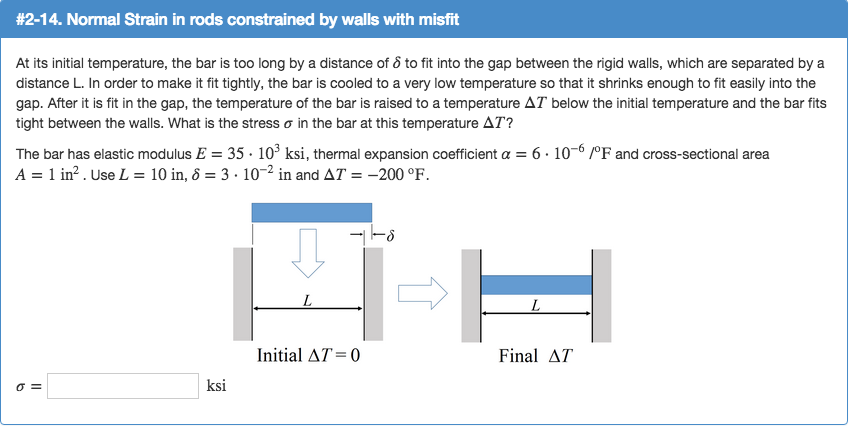#2-14. Normal Strain in rods constrained by walls with misfit At its initial temperature, the bar is too long by a distance of 8 to fit into the gap between the rigid walls, which are separated by distance L. In order to make it fit tightly, the bar is cooled to a very low temperature so that it shrinks enough to fit easily into th gap. After it is fit in the gap, the temperature of the bar is raised to a temperature AT below the initial temperature and the bar tight between the walls. What is the stress o in the bar at this temperature AT'? The bar has elastic modulus E = 35 10³ ksi, thermal expansion coefficient a = 6.10-6/°F and cross-sectional area A = 1 in². Use L 10 in, 8 = 3. 10-2 in and AT = -200 °F. L L
#2-14. Normal Strain in rods constrained by walls with misfit At its initial temperature, the bar is too long by a distance of 8 to fit into the gap between the rigid walls, which are separated by distance L. In order to make it fit tightly, the bar is cooled to a very low temperature so that it shrinks enough to fit easily into th gap. After it is fit in the gap, the temperature of the bar is raised to a temperature AT below the initial temperature and the bar tight between the walls. What is the stress o in the bar at this temperature AT'? The bar has elastic modulus E = 35 10³ ksi, thermal expansion coefficient a = 6.10-6/°F and cross-sectional area A = 1 in². Use L 10 in, 8 = 3. 10-2 in and AT = -200 °F. L L
Chapter2: Loads On Structures
Section: Chapter Questions
Problem 1P
Related questions
Question

Transcribed Image Text:# 2-14. Normal Strain in rods constrained by walls with misfit
At its initial temperature, the bar is too long by a distance of 8 to fit into the gap between the rigid walls, which are separated by a
distance L. In order to make it fit tightly, the bar is cooled to a very low temperature so that it shrinks enough to fit easily into the
gap. After it is fit in the gap, the temperature of the bar is raised to a temperature AT below the initial temperature and the bar fits
tight between the walls. What is the stress in the bar at this temperature AT?
The bar has elastic modulus E = 35. 10³ ksi, thermal expansion coefficient a = 6.10-6 /°F and cross-sectional area
A = 1 in². Use L = 10 in, 8 = 3 . 10-² in and AT = -200 °F.
0 =
ksi
L
Initial AT=0
L
Final AT
Expert Solution
This question has been solved!
Explore an expertly crafted, step-by-step solution for a thorough understanding of key concepts.
Step by step
Solved in 2 steps with 2 images

Knowledge Booster
Learn more about
Need a deep-dive on the concept behind this application? Look no further. Learn more about this topic, civil-engineering and related others by exploring similar questions and additional content below.Recommended textbooks for you


Structural Analysis (10th Edition)
Civil Engineering
ISBN:
9780134610672
Author:
Russell C. Hibbeler
Publisher:
PEARSON

Principles of Foundation Engineering (MindTap Cou…
Civil Engineering
ISBN:
9781337705028
Author:
Braja M. Das, Nagaratnam Sivakugan
Publisher:
Cengage Learning


Structural Analysis (10th Edition)
Civil Engineering
ISBN:
9780134610672
Author:
Russell C. Hibbeler
Publisher:
PEARSON

Principles of Foundation Engineering (MindTap Cou…
Civil Engineering
ISBN:
9781337705028
Author:
Braja M. Das, Nagaratnam Sivakugan
Publisher:
Cengage Learning

Fundamentals of Structural Analysis
Civil Engineering
ISBN:
9780073398006
Author:
Kenneth M. Leet Emeritus, Chia-Ming Uang, Joel Lanning
Publisher:
McGraw-Hill Education


Traffic and Highway Engineering
Civil Engineering
ISBN:
9781305156241
Author:
Garber, Nicholas J.
Publisher:
Cengage Learning